|
Cairo is the capital of Egypt and has a population of 20+ million people. It is huge and the pollution unfortunately distracts you from enjoying it more. The city is on the move from the crack of dawn to the early morning hours. The number of cars is overwhelming and the traffic horrendous. Trying to cross a street anywhere can be a life-threatening experience. All that aside, it has a great deal of history and is worth at least a short visit.
We started our sightseeing with an early morning visit to the pyramids. These were erected during the Old Kingdom period and the oldest and largest is that of Cheops who ruled until about 2566 BC. We wanted to arrive there early in the morning because they limit the number of visitors inside this great pyramid (the large one in the photo below).
Well, we weren’t early enough. As we were standing in line, they closed the ticket booth for an hour. So we took some time to walk around this and the Chephren pyramids and take some pictures. One of he sergeant’s of the Tourist Police led us to a spot to take a photo where you can see all three pyramids (above). Then asked for his baksheesh. Jim held out 50 piastres (the usual baksheesh amount) to which the sergeant replied “5 Euro.” Jim started to put the 50 piastres away. “Okay, okay” says the sergeant and takes the money, heading off after another tourist. Above is the picture that cost us 50 piastres. The nearest pyramid is that of Cheops, Chephren to the left, and in the far distance a barely visible Mycerinus nestled in the “V” between Chephren and a much smaller pyramid on the left side of the picture.
We then headed to the pyramid of Mycerinus where we entered to view the tomb area. As we climbed up the steps to the entrance, the tourist police stopped anyone with a video camera as they are not allowed. It took several minutes to convince them our digital camera was only a still camera, not video. When you get to the entrance passage, you have to immediately duck down as the ceiling is only about 3 feet high. And the passage slopes downward at about a 10 degree angle (photo, above left). And there are people coming out as you are going in. All in all, not a place for those with claustrophobia as the picture above shows. It takes several minutes to climb down the ramp into the tomb area itself. The tomb is simply a big opening in the stone - no decorations, carvings, or anything else other than hot, stuffy air as not much ventilation is possible. There are a couple of other small rooms inside, but not much to see. It is more the idea that you are actually inside one of the great pyramids that holds everyone’s fascination as our photo above right shows. Of course, there is the man inside asking for his baksheesh after pointing to the original entrance (just above the passage we came in) and pointing downstairs to the other rooms. Then you get to climb back out, climbing upward while bending over at the waist. This was especially difficult for the tall guys like Jim. Once we got to the opening, we deeply breathed the air - even the Cairo air seemed good.
We then drove to the point where you can get a view of all three pyramids (below). The sight is truly amazing. Unfortunately, the day was so smoggy, you could barely see them and it somewhat spoiled the effect. The camels were there for rides and the usual line of vendors, each eager to sell you whatever they can.
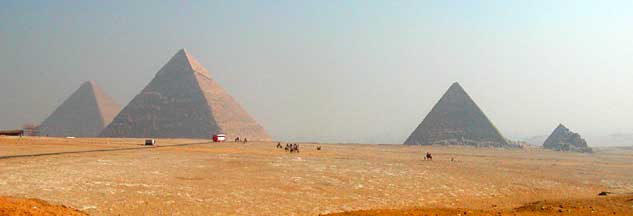 |
Just down the hill from the pyramids lies the great Sphinx - another awe-inspiring sculpture carved out of solid sandstone. A lot of restoration work has been done on the lower parts (his feet and most of his legs) to repair damage from the environment. Still, it is an impressive sight. Below left the great Sphinx sits proudly as is guarding the pyramid of Chephren.
Next to the Sphinx is the funerary temple of Chephren where the embalming of the pharaoh was done. This was much less decorated than the temples we had seen earlier in the week along the Nile, but was for a very different purpose. The construction show the engineers knew how to build a strong structure that would withstand earthquakes to some degree. The corners were not just blocks abutting each other, but the blocks themselves were cut around the corners. As well, the blocks were cut to different sizes and angles to provide more strength (photo, above right). But the truly impressive part are the joints themselves as they fit the adjoining blocks perfectly - no mortar was used and there are no gaps. The temple had an underground hall that led to the pyramid so the body of the pharaoh could be carried directly there.
During the afternoon and evening, we decided to head out on our own to explore Cairo on foot. The first thing you must learn is how to cross the street as there are no stoplights where cars actually stop. One method is to simply follow the locals, but you must watch both them and the cars to make sure you make it safely. We learned by watching them that you simply attack one lane at a time (if you wait for all lanes to clear, you would still be there). So cross one lane, then stop between lanes until the next lane has a break, and so on. We noticed that the locals never run - they simply walk at their own pace and the cars go around them. If you are in the street, the cars will stop for you if they have to, but they obviously prefer not to.
We were looking for the Hard Rock Cafe to buy a guitar pin for our friend Mary, but got wrong directions from the hotel concierge. One local tried to help us, telling us he was studying to be a doctor to get our confidence, then tried to lure us toward some other “government” shops that had some great sales but were in the other direction. We told him we would go our way and see what we could find and thanked him for his help.
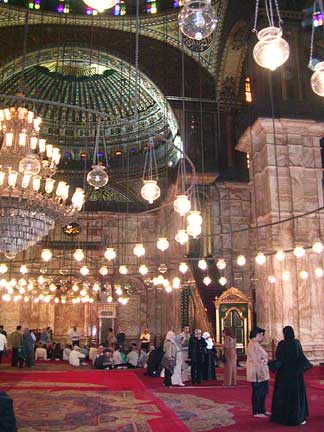 Two blocks later we were befriended by another local, this one a “teacher” and led us to the center where the concierge told us to go. The cafe was not there, but the gentleman thought the cafe was in the Meridian Hotel and he would take us there. So we followed along and had a nice chat on the way. He led us on a circuitous route, although we kept our bearings so we roughly knew where we were. He then invited us to a tea in a small cafe along the way. We accepted his hospitality and enjoyed our break. Off again, he led us around-about to the hotel where we did indeed find the cafe. We purchased a pin, then set off again. Now our friend wanted to take us to a park in the other direction and we gently declined his offered. We walked together back toward our hotel, chatting about Cairo and a bit about the current world situation. About halfway back, he wanted us to join him for dinner, but we replied we didn’t eat dinner. We walked on and now he is beginning to lag behind a bit. The he tells us he was going for a trip soon and needed help getting US dollars. Would we trade him dollars for Egyptian Pounds? Sorry, we don’t have any dollars. We continue walking. Would we join him for a beer? Sorry, Verna doesn’t drink beer and Jim only drinks German beer (not available here). We continue walking. He tells us he knows this community of blind people that really don’t have much of anything and he is going to see them and could take them fruit and bread; they really are needy. We keep walking. Finally we get to a main thoroughfare that we need to cross and he doesn’t seem eager to do so. So he asks for a little money for his friends; Jim hands him a few pounds as his baksheesh for helping find the cafe, as we congenially part ways. We knew going in what the game was, but decided we could probably play it at least as well as he could. Two blocks later we were befriended by another local, this one a “teacher” and led us to the center where the concierge told us to go. The cafe was not there, but the gentleman thought the cafe was in the Meridian Hotel and he would take us there. So we followed along and had a nice chat on the way. He led us on a circuitous route, although we kept our bearings so we roughly knew where we were. He then invited us to a tea in a small cafe along the way. We accepted his hospitality and enjoyed our break. Off again, he led us around-about to the hotel where we did indeed find the cafe. We purchased a pin, then set off again. Now our friend wanted to take us to a park in the other direction and we gently declined his offered. We walked together back toward our hotel, chatting about Cairo and a bit about the current world situation. About halfway back, he wanted us to join him for dinner, but we replied we didn’t eat dinner. We walked on and now he is beginning to lag behind a bit. The he tells us he was going for a trip soon and needed help getting US dollars. Would we trade him dollars for Egyptian Pounds? Sorry, we don’t have any dollars. We continue walking. Would we join him for a beer? Sorry, Verna doesn’t drink beer and Jim only drinks German beer (not available here). We continue walking. He tells us he knows this community of blind people that really don’t have much of anything and he is going to see them and could take them fruit and bread; they really are needy. We keep walking. Finally we get to a main thoroughfare that we need to cross and he doesn’t seem eager to do so. So he asks for a little money for his friends; Jim hands him a few pounds as his baksheesh for helping find the cafe, as we congenially part ways. We knew going in what the game was, but decided we could probably play it at least as well as he could.
The next day we headed out with a personal guide to see the city sights. She hired a driver so getting around was fairly easy. We first visited the Mohammed Ali Pasha mosque set high on a hill above Cairo, next to the citadel. The mosque was built in the early 1900s by Mohammed Ali, a self-imposed ruler from Turkey. The mosque has many Turkish features and is said to have the same plan as the Blue Mosque in Turkey. Inside the main ceiling decorations are green (the color of Islam) as opposed to blue in the Blue Mosque. The interior walls are a creamy alabaster and the overall effect is stunning. The large chandelier in the center is a gift from the French.
Outside the mosque is the open courtyard usually found in large mosques. In the center is a water fountain used for cleansing before prayers. Unfortunately it no longer functions, possibly because the Nile is much lower today. The mosque is still in use today so is closed to tourists for a period on Fridays for prayers.
From the hill you have a fantastic panorama of Cairo and you can see just how big it really is. The day we were there the smog again was a problem, so not much was visible except an expanse of brown. Next to the Mosque is the citadel from the 12th century. Nasser was the last to use it and it sits unused today and is closed to the public.
Our next stop was as visit to the Khan al-Khalili or bazaar. This are was once the heart of the shopping district, but today is now mostly for the benefit of the tourists. Nonetheless, it is interesting to wander through. Below left is a photo of an old entryway into the market, with the narrow shopping street visible through the arch. While we were there it was fairly quiet as most of the tour busses had not yet arrived. There are also several cafes where you can have a tea or a smoke from a water pipe. We stopped at a very nice old cafe where we enjoyed a wonderfully refreshing juice drink made of hibiscus and tamarind. It was a lovely bright red with a full flavor and hint of tartness.
Next we went into the city center to visit the Museum of Egyptian Antiquities, a must-see for any visitor as it has an excellent collection of relics covering some 6000 years. The highlight of course are the treasures from the tomb of Tutankhamun. The volume of items found was quite impressive. The volume of gold used to make or gild the items was also impressive - one coffin weighed 111 kilos and it was made of solid gold! The ceremonial chair is very ornate, with a picture of Tut and his queen on the back, to the representation of his enemies under his feet. Above right is the gold mask of King Tut. The amazing part of Tutankhamun's burial is the layering of tombs. Tutankhamun was covered in jewelry and gold, then placed inside of a solid gold casket placed inside another inside another. This was then placed inside a gold-gilded box fitted inside another inside another.
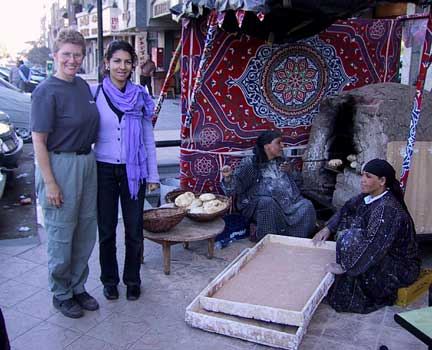 The museum contains many beautiful sculptures and carving, each more beautiful than the last. There are also countless sphinx and pharaoh sculptures as well as an impressive display of mummies and sarcophagi. The exhibits are displayed roughly by date, so you can wander through the Old Kingdom (about 2686-2181 BC), Middle Kingdom (about 2050-1786 BC) and New Kingdom (about 1567-1085 BC), as well as later periods. The museum contains many beautiful sculptures and carving, each more beautiful than the last. There are also countless sphinx and pharaoh sculptures as well as an impressive display of mummies and sarcophagi. The exhibits are displayed roughly by date, so you can wander through the Old Kingdom (about 2686-2181 BC), Middle Kingdom (about 2050-1786 BC) and New Kingdom (about 1567-1085 BC), as well as later periods.
Our last stop was for lunch at a restaurant buffet that obviously catered to tour groups, but we found many locals as well. The food was very good and had several Egyptian specialties like meat balls in an Egyptian tomato sauce, chicken with vegetables, pickled eggplant, all served with tahini and yogurt sauces. The highlight was the fresh bread, baked right out front in a mud oven, pictured at left with Verna and Shaima, our guide in Cairo. She did a very good job and we recommend her highly.
That evening we went on another long walk, but this time didn’t run into any helpful locals. We walked to the island of Zamalek where we we shopped a bit in a bookstore then had a fresh juice at Cilantro, a cozy, non-smoking cafe. Walking back to our hotel, there were lots of people strolling along the riverside promenade enjoying the fresh evening. We stopped for a photo of the Nile at night with the lights reflecting in the water (below). The Cairo tower is the tall narrow building you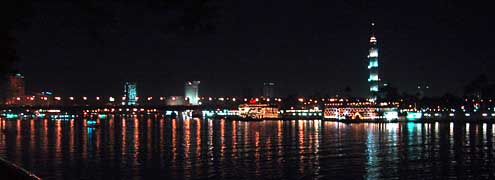 see on the right. see on the right.
Overall, the visit to Cairo was well worth it and we recommend it to anyone, but it would have been difficult for us to have stayed longer than a couple of days. Between the noise and smog, it is a difficult place to relax.
For additional photos of the Cairo area, click here.
For more photos of the Museum of Egyptian Antiquities, click here.
|

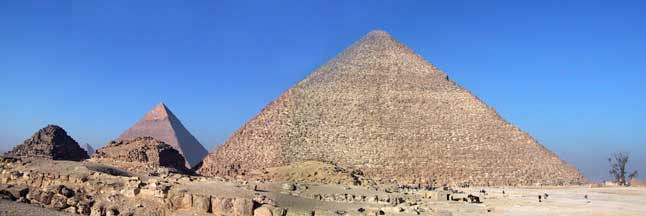
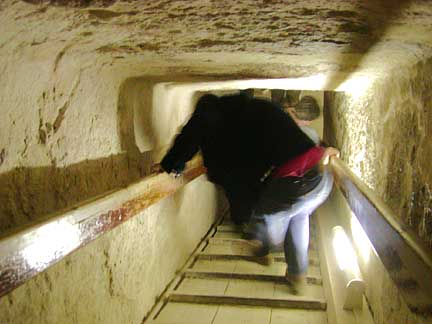
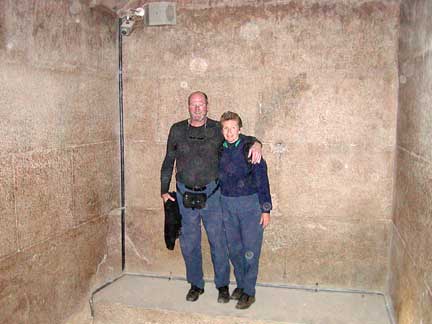

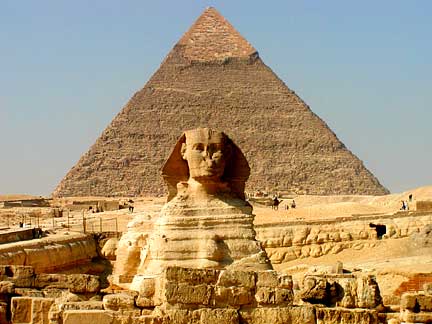
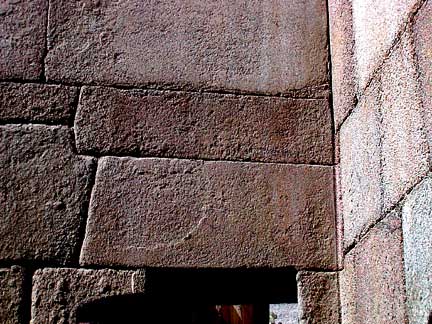
 Two blocks later we were befriended by another local, this one a “teacher” and led us to the center where the concierge told us to go. The cafe was not there, but the gentleman thought the cafe was in the Meridian Hotel and he would take us there. So we followed along and had a nice chat on the way. He led us on a circuitous route, although we kept our bearings so we roughly knew where we were. He then invited us to a tea in a small cafe along the way. We accepted his hospitality and enjoyed our break. Off again, he led us around-about to the hotel where we did indeed find the cafe. We purchased a pin, then set off again. Now our friend wanted to take us to a park in the other direction and we gently declined his offered. We walked together back toward our hotel, chatting about Cairo and a bit about the current world situation. About halfway back, he wanted us to join him for dinner, but we replied we didn’t eat dinner. We walked on and now he is beginning to lag behind a bit. The he tells us he was going for a trip soon and needed help getting US dollars. Would we trade him dollars for Egyptian Pounds? Sorry, we don’t have any dollars. We continue walking. Would we join him for a beer? Sorry, Verna doesn’t drink beer and Jim only drinks German beer (not available here). We continue walking. He tells us he knows this community of blind people that really don’t have much of anything and he is going to see them and could take them fruit and bread; they really are needy. We keep walking. Finally we get to a main thoroughfare that we need to cross and he doesn’t seem eager to do so. So he asks for a little money for his friends; Jim hands him a few pounds as his baksheesh for helping find the cafe, as we congenially part ways. We knew going in what the game was, but decided we could probably play it at least as well as he could.
Two blocks later we were befriended by another local, this one a “teacher” and led us to the center where the concierge told us to go. The cafe was not there, but the gentleman thought the cafe was in the Meridian Hotel and he would take us there. So we followed along and had a nice chat on the way. He led us on a circuitous route, although we kept our bearings so we roughly knew where we were. He then invited us to a tea in a small cafe along the way. We accepted his hospitality and enjoyed our break. Off again, he led us around-about to the hotel where we did indeed find the cafe. We purchased a pin, then set off again. Now our friend wanted to take us to a park in the other direction and we gently declined his offered. We walked together back toward our hotel, chatting about Cairo and a bit about the current world situation. About halfway back, he wanted us to join him for dinner, but we replied we didn’t eat dinner. We walked on and now he is beginning to lag behind a bit. The he tells us he was going for a trip soon and needed help getting US dollars. Would we trade him dollars for Egyptian Pounds? Sorry, we don’t have any dollars. We continue walking. Would we join him for a beer? Sorry, Verna doesn’t drink beer and Jim only drinks German beer (not available here). We continue walking. He tells us he knows this community of blind people that really don’t have much of anything and he is going to see them and could take them fruit and bread; they really are needy. We keep walking. Finally we get to a main thoroughfare that we need to cross and he doesn’t seem eager to do so. So he asks for a little money for his friends; Jim hands him a few pounds as his baksheesh for helping find the cafe, as we congenially part ways. We knew going in what the game was, but decided we could probably play it at least as well as he could.
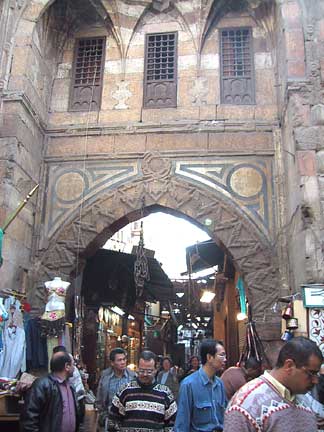
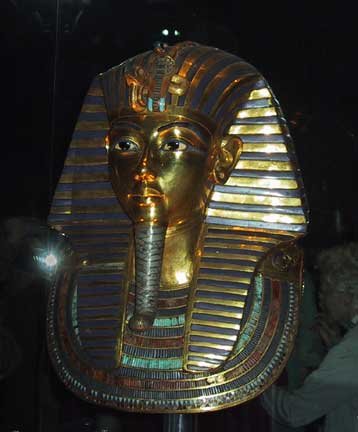
 The museum contains many beautiful sculptures and carving, each more beautiful than the last. There are also countless sphinx and pharaoh sculptures as well as an impressive display of mummies and sarcophagi. The exhibits are displayed roughly by date, so you can wander through the Old Kingdom (about 2686-2181 BC), Middle Kingdom (about 2050-1786 BC) and New Kingdom (about 1567-1085 BC), as well as later periods.
The museum contains many beautiful sculptures and carving, each more beautiful than the last. There are also countless sphinx and pharaoh sculptures as well as an impressive display of mummies and sarcophagi. The exhibits are displayed roughly by date, so you can wander through the Old Kingdom (about 2686-2181 BC), Middle Kingdom (about 2050-1786 BC) and New Kingdom (about 1567-1085 BC), as well as later periods. see on the right.
see on the right.